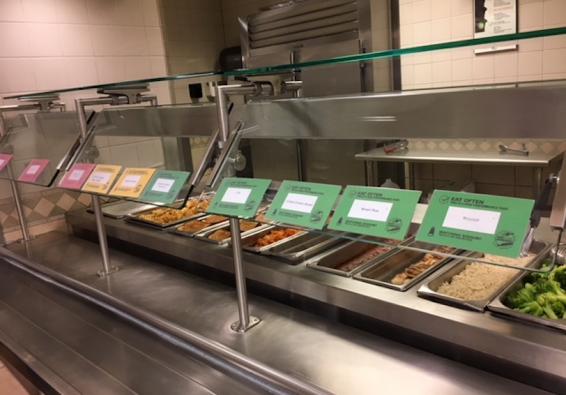What are the menu requirements for G4G 2.0?
G4G 2.0 labels Green-coded items as “better for you” choices and requires G4G 2.0 facilities to provide more Green-coded options for diners. The G4G 2.0 Program Requirements include Menu Coding Goals for breakfast and lunch/dinner. In general, there should always be a Green-coded option for each meal part (entrée, starchy side, non-starchy side, etc.) at each station (Main line, Short Order/Grill, specialty bar, etc.) for each meal served daily.
How do I find out how “Green” my current dining facility menu is?
The first step to revising your menu is to find out how it compares with G4G standards. A certified G4G Coder should code your current menu and compare it to the Menu Coding Goals. For example, your facility might be meeting the goals in one area such as the Salad Bar but need work in other areas such as the Short Order/Grill or Main line. Don’t worry—it’s to be expected and built into the G4G implementation timeline.
How can I make my dining facility more “Green”?
G4G 2.0 promotes making more Green-coded menu items available and accessible. This can mean replacing current menu items with newer versions, substituting healthier ingredients to change favorite recipes from Red or Yellow to Green, or introducing diners to new recipes or ingredients. Most dining facilities use a combination of these strategies to make their menu G4G 2.0 compliant.
If you find your dining facility’s current menu falls short of the Menu Coding Goals, there are many valuable resources to help create a performance-enhancing menu:
- Sample Menus (more coming soon!) include Armed Forces Recipe Service (AFRS) recipe names and numbers.
- G4G Guideline Cards provide ideas and best practices for a variety of specialty and theme bars, including food placement/set-up guidance, ideas for food items, “Featured Meal” concepts, and suggested items to meet Menu Coding Goals.
- Standardized AFRS recipes are pre-coded with G4G color and sodium codes.
How can I speed up the menu revision process?
Follow these best practices to create a menu that meets the Menu Coding Goals:
- Develop your menu using the AFRS pre-coded recipes found on the G4G section of the HPRC website. These recipes save time and effort because they’re standardized recipes that are already coded with the correct G4G color code (Green, Yellow, or Red) and sodium code (Low, Moderate, or High).
- Use the G4G Guideline Cards and Sample Menus as inspirations! It’s easy to make changes to your menu, add new elements (new or revised specialty bar) to your facility, or update menu items with the simple, straightforward Guideline Cards.
- If you’re revising menus for more than one dining facility at your installation, work with the other dining facilities to create one menu that serves all the facilities. You also can provide variety to your diners by alternating weeks. For example, dining facility X starts on the first week of the menu and dining facility Y starts on week 2 of the menu, etc. Dining facilities also can offer different specialty/theme bars to increase choices and variety for diners.
I’m interested in trying new recipes at my dining facility/galley. Where can I get them?
Providing more variety and more Green-coded recipes is an important component of G4G 2.0, so it’s great you’re interested in trying new recipes. AFRS has a large collection of new and updated recipes that are housed on the G4G section of the HPRC website. The AFRS G4G-coded Recipes spreadsheet provides an overview of the AFRS recipe collection, including the recipe name, number, category, portion size, and G4G color and sodium codes. Once you locate a recipe of interest on the spreadsheet, go to the AFRS Recipes section, select a category, and scroll down until you find the recipe. Or you can search by recipe number (for example, L-040-05) in the “search bar” on the HPRC website, download the recipe, and save or print it for your use.
